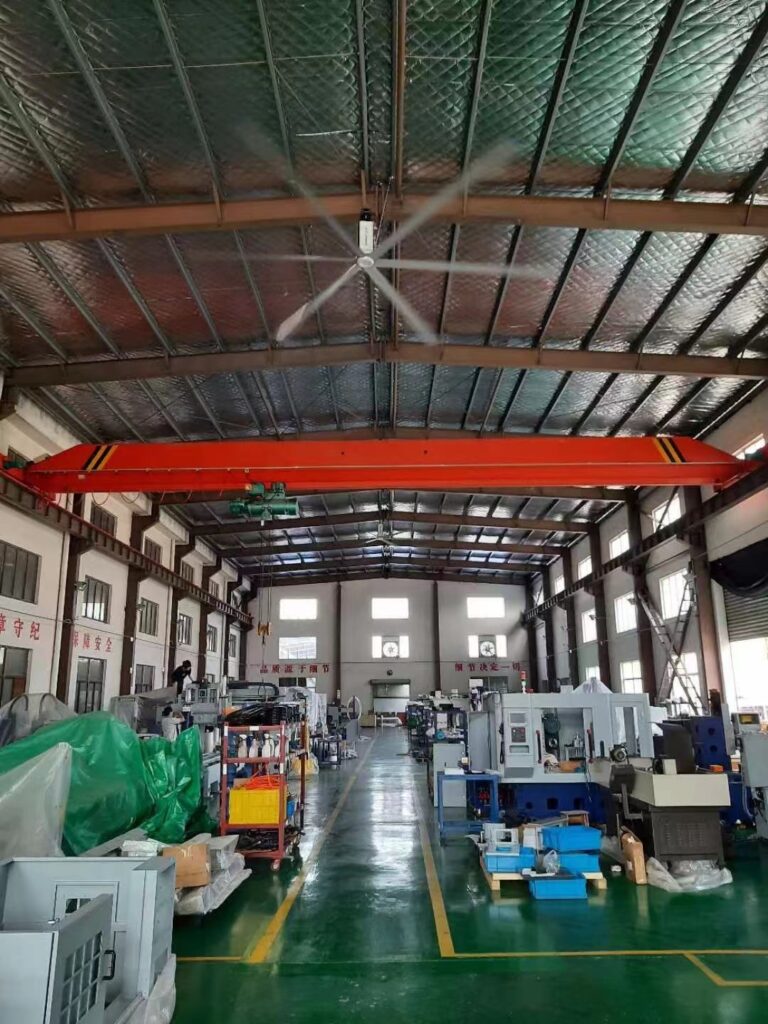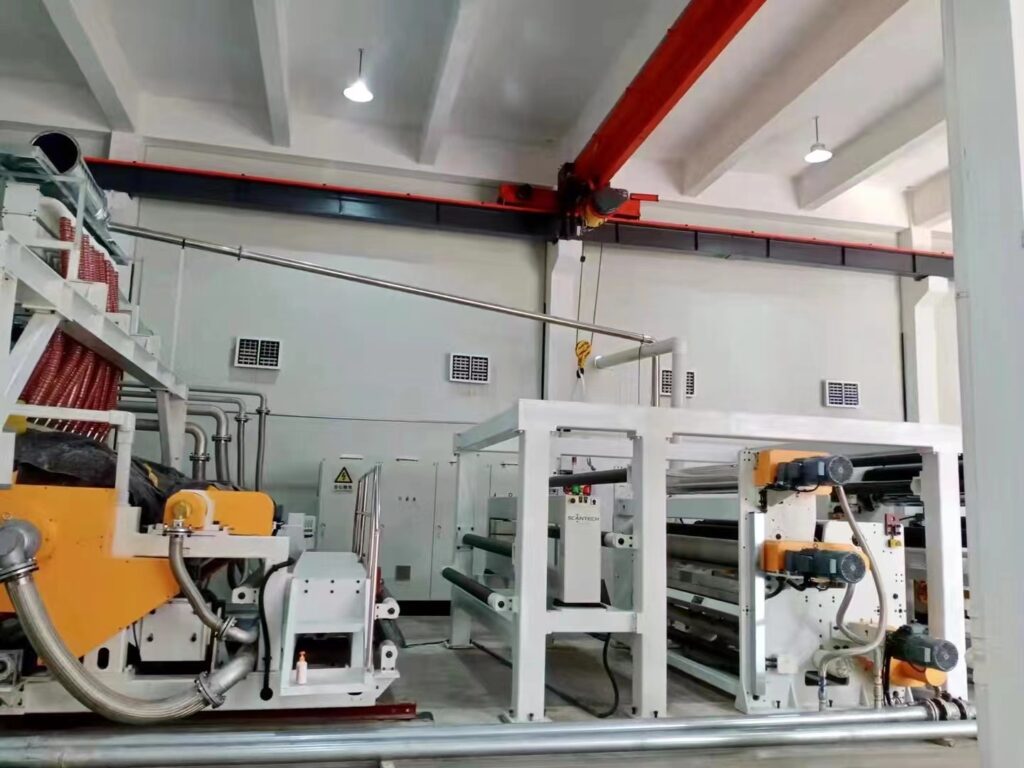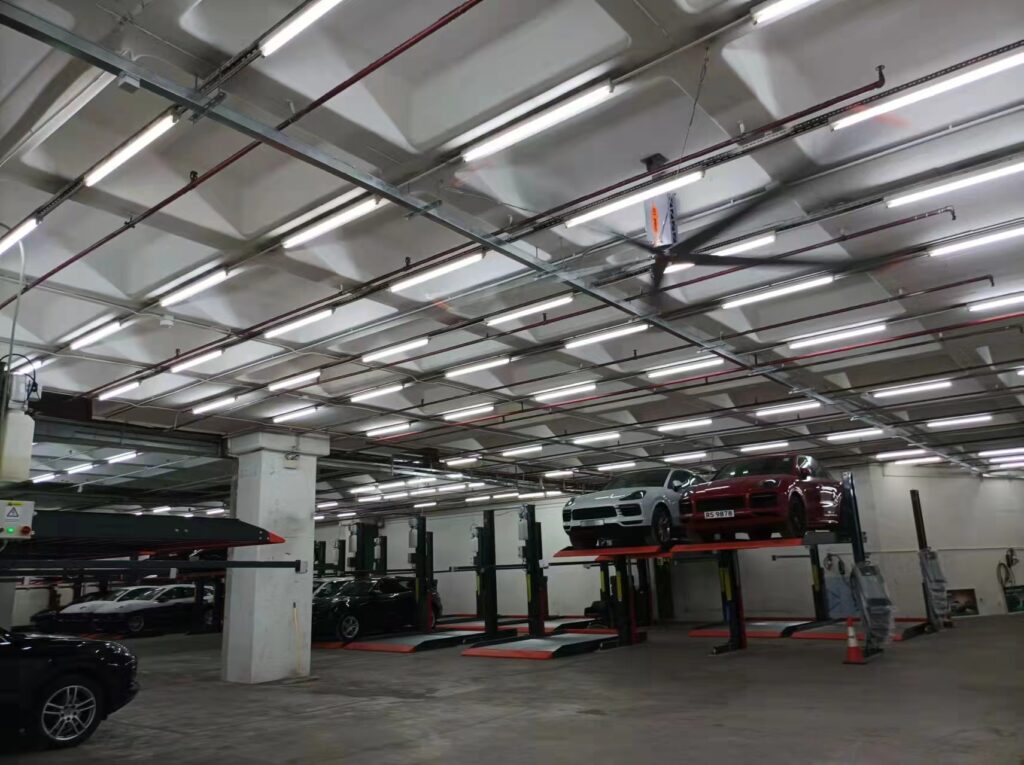The towering ceilings of high-bay warehouses and their large storage facilities present distinct ventilation problems, which can escalate energy expenses and negatively affect employee productivity. Typically, these facilities that may be over 30 feet high need special solutions to keep the temperatures and air quality constant. The HVLS fans, with their power to transport large amounts of air at a low speed, are uniquely adapted to meet these concerns. High bay warehouse HVLS fans are more beneficial to a high-bay warehouse than almost any other type of facility since they destratify layers of air, enhance airflow, and reduce energy expenses significantly. HVLS fans will revolutionize tall ceilings and industrial ceiling fan warehouse applications by making them 20-30% independent of HVAC and covering large spaces with one fan. We will cover the problems, why HVLS fans are the best solution, why they are superior to other facilities, operational advantages, ROI, and some practical knowledge.
The Unique Challenge of High-Bay Warehouses
High-bay warehouses are tall, 30-60 feet, designed to be as large as possible with racks of inventory used in logistics, e-commerce, or manufacturing applications. Their size, however, makes it difficult to ventilate them, posing major operational challenges.
Ceiling Heights and Stratification
Having a ceiling 30-60 feet in the air leads to a lot of stratification of the air, where the warm air rises and gets trapped near the ceiling, leaving the cooler air at the bottom. This may cause temperature variations of 10-20 degrees F between the floor and ceiling, making them overwork to cool or heat the lower occupied areas. According to ASHRAE requirements, stratification of high-ceiling spaces causes 15-25 percent of energy wastefulness because systems cannot easily transfer air over the ceiling.

HVAC Struggles with Air Distribution
The HVACs of large-bay warehouses do not always have the capacity to accommodate the area or are designed poorly around tall spaces, resulting in uneven cooling. Areas around loading docks or cold spaces in storage aisles are commonplace, causing discomfort to the workers and risking damage to the inventory. Conventional ventilation, such as small fans, is not powerful enough to deal with these large spaces; therefore, tall warehouse ventilation options are of the essence.
Energy Waste and Uneven Comfort
Warehouses may dedicate 20-40% of their operating budgets to energy expenses, with HVAC taking up the majority of these expenditures. Poor air circulation causes too much cooling during the summer or heating during the winter, which drives up the bills. Employees report feeling uneasy in these unequal areas, and heat pressure is tough on productivity during the summer months, up to 20 percent of productivity due to heat stress, according to OSHA heat safety research. These issues indicate the necessity of destratification fans in warehouses to optimize the situation.
Why HVLS Fans Are the Perfect Solution
HVLS fans have 8-24-foot diameter blades, and at low speeds (50-100 RPM), can move up to 400,000 cubic feet per minute, making them uniquely suited to high-bay warehouses. Their design concerns the main problems of stratification and inefficiency.
Destratification for Year-Round Efficiency
HVLS fans outperform the warehouse destratification fans in that they can move warm air downwards in the winter months to save on heating bills by up to 20-30 per cent, and in the summer months, they can create a cooling breeze that can drop perceived temperatures by up to 5-10 °C. This is in line with ASHRAE Standard 55 on thermal comfort, which provides uniformity throughout the warehouse floor. Cutting the stratification, fans save energy and keep workers comfortable throughout the year.

Large Coverage Area
One HVLS fan serves an area of 10,000-22,000 square feet and is, therefore, suitable as an airflow fan in large warehouses. Dozens of smaller fans would be required to obtain a uniform airflow in the 100,000-square-foot warehouse, which just a few larger fans can accomplish. This scalability is beneficial to installations and ease of maintenance to address the size of high-bay spaces.
Energy Savings
Compared to HVAC systems (50-200 kW to serve similar areas), HVLS fans consume less than 1.5 kW. Complementing HVAC, they enable thermostat settings to be set higher, 3-5 degrees in summer to save 4% of energy per degree, and less heating requirements in winter. HVAC energy savings of 20-30% have been the industry standard, equating to 10,000-50,000 savings per year in large warehouses.
Comparison with Other Facilities
The stratification of high-bay warehouses is even stronger than seen in smaller warehouses, such as offices or retail stores, which generally have a ceiling height of 8-15 feet. Smaller fans or HVAC systems are adequate in offices because air volumes are lower, and stratification is not a major issue. The retailing areas are more aesthetic, and the size of the fan is restricted. The distinctive size of high-bay warehouses depends on HVLS fans and tall ceilings to move air in the warehouse and, therefore, requires HVLS solutions more than other warehouses.
As an example, an office of 10,000 square feet can have standard HVAC, whereas a warehouse of 100,000 square feet high-bay needs HVLS fans to cover 30 feet or more. This explains why HVLS fans are most effective in high bay warehouses: there is no other type of facility where such large-scale destratification is required.
Operational Benefits
HVLA fans are practical and can benefit operations in the warehouse beyond cooling.
Protecting Inventory from Humidity and Temperature Fluctuations
Summer heat or inadequate ventilation might cause damage to inventory, such as electronics or perishables, due to high humidity. HVLS fans lower the humidity level by 10-15, eliminating the development of molds and corrosion. The uniform temperatures preserve delicate products, lowering spoilage at least by 15 percent, as in a food distribution warehouse.

Improving Worker Comfort and Reducing Fatigue
Enhanced air circulation decreases floor condensation, which reduces the risk of slips by 20 percent. Fans also dilute dust and fumes, which is in line with OSHA air quality standards (29 CFR 1910.1000), to provide more comfortable workplaces.
Enhancing Safety
HVLS fans have attractive economics. A 100,000-square-foot warehouse would cost between $20,000 and 60,000 to install (4-6 fans), with annual energy savings of 10,000-50,000, realizing a payback period of 12-24 months. Maintenance is low (200-500/year), fans last 15-20 years, versus HVAC systems that need 5,000-20,000/year maintenance and have a life of 10-15 years. This would allow HVLS fans to be an economical alternative to HVLS fans’ energy storage facilities.
ROI Analysis
HVLS fans have attractive economics. A 100,000-square-foot warehouse would cost between $20,000 and 60,000 to install (4-6 fans), with annual energy savings of 10,000-50,000, realizing a payback period of 12-24 months. Maintenance is low (200-500/year), fans last 15-20 years, versus HVAC systems that need 5,000-20,000/year maintenance and have a life of 10-15 years. This would allow HVLS fans to be an economical alternative to HVLS fans’ energy storage facilities.
Case Scenario: A Warehouse Success Story
A 150,000-square-foot high-bay e-commerce warehouse experienced summer heat issues with temperatures up to 95 o C near racks. Productivity was down by 15 percent, and absenteeism by 10 percent. A six-unit 20-foot HVLS system decreased perceived temperatures by 8 °C, increasing output by 18 percent and saving HVAC expenses by 25 percent, or the equivalent of $30,000/year. Employee morale was boosted, and humidity-related damages to inventory were reduced by 12%. This is an exhibition of ceiling fans, productivity warehouse employees.
FAQ: Common Questions About HVLS Fans in High-Bay Warehouses
- What is destratification, and why is it important in warehouses?
The effect of destratification is the mixing of warm and cool air layers and thus lowering the temperature variation in high areas. Saving energy and maintaining comfort is critical to the warehouse destratification fans. - Can HVLS fans replace HVAC in tall facilities?
Yes, in mild climates, where they can be used as a ventilation aid; in hot climates, they are used to supplement HVAC, reducing the cost of cooling solutions in tall ceiling warehouses by 20-30%. - How many fans does a high-bay warehouse need?
One fan per 15,000 to 20,000 square feet, and to diegetically, a 100,000 square-foot warehouse requires 4-6 big warehouse airflow fans. - Do HVLS fans improve worker safety?
Yes, they are compliant with OSHA safety standards by decreasing humidity and slip hazards, and they are helpful to ceiling fans, productivity, warehouses, and workers.
Conclusion
Such large and tall warehouses with their high ceiling are not affected by the issue of ventilation that HVLS fans can solve like no other. The HVLS fans protect productivity and stock by destratifying air, increasing air circulation, and saving power costs by 20-30% percent, in comparison to high bay warehouses. The ventilation strategy of the warehouse operators should focus on HVLS fans as they are necessary to be efficient in the long term and comfortable for the workers. RTFANS has 20-plus years of experience in offering warehouse solutions for industrial ceiling fans, which are tailor-made. Contact us now to turn your high-bay warehouse; your company cannot do without the best.
